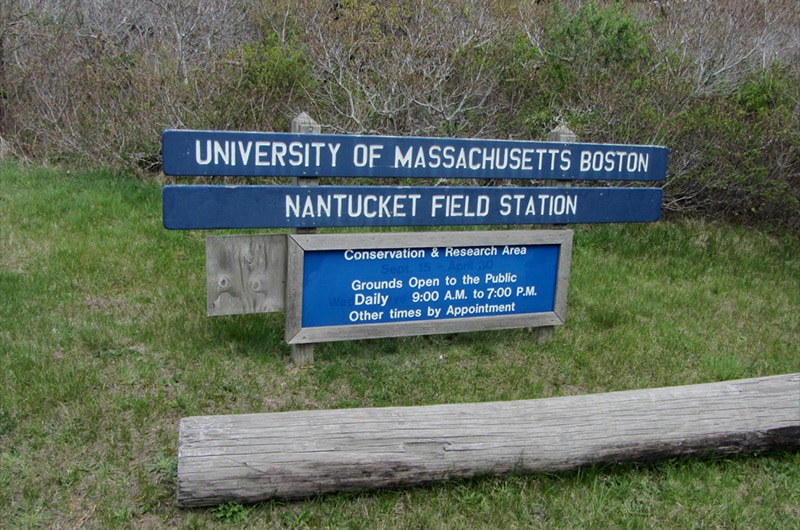~ by Dr. Sarah D. Oktay, Director, University of Massachusetts Nantucket Field Station ~
This week I am fortunate to be hosting Andy Revkin for an on-island event to support the Organization of Biological Field Stations (www.obfs.org) in my role as the current President of OBFS. Andy was the science and environmental beat writer for the New York Times for 14 years and currently writes an excellent science blog for the New York Times called Dot Earth (http://dotearth.blogs.nytimes.com/). He has written extensively on climate related issues including the evolution of the Arctic and the crisis of communication that stymies many scientists as they try to describe their methods and conclusions to a public unsure of the scientific process. Andy coined the term Anthrocene in his book Global Warming: Understanding the Forecast (1992), in which he wrote, “we are entering an age that might someday be referred to as, say, the Anthrocene. After all, it is a geological age of our own making.” The name evolved into the term scientists use now of Anthropocene (“anthropo” from the Greek word for “human” and “cene” for “new”) to describe the current geologic age as one in which human impacts are causing ecosystem wide change and have become the dominant driver of many earth processes.
Andy reminded me of a group that came here for the 2010 “Living on the Edge” Coastal Communities Conference (held by ReMain Nantucket and the Egan Maritime Institute) called Atlantic Rising. Atlantic Rising was a two year charitable project created by a group of three young Brits (Tim Bromfield, Will Lorimer, and Lynn Morris) who traveled the world showing people what a one meter (three foot) sea level rise would look like on the ground (http://www.atlanticrising.org/default.asp). They took their blog, videos, and other material and morphed it into educational resources for students aged 12-15. I spoke with the group back in 2010 and I was really impressed by their mission and their ability to viscerally show an average person what sea level rise would look like. They filmed a video with Andy with high school students on Nantucket working with local surveyor Art Gasbarro to measure and mark the one meter level at Brant Point using yellow caution tape http://dotearth.blogs.nytimes.com/2010/09/27/linking-students-over-rising-atlantic-waters/.
I don’t think we necessarily need caution tape to remember that Nantucket, like many other low lying islands, is extremely vulnerable to sea level rise. The recent winter storms over the past three years have drilled into us the need to plan for sea level rise and to prepare for these storms in intelligent ways. The Town of Nantucket developed a Coastal Management Plan (http://www.nantucket-ma.gov/281/Coastal-Management-Plan-Work-Group) to set up protocols and an action plan to deal with town owned land in harm’s way from storm surge and erosion that was completed in 2014.
The Cape and the Islands were formed during the Wisconsin Glaciation period when a lobe of the Laurentide Ice Sheet (named the Laurentide after the Laurentian region of Canada where it first formed) pushed rocks and debris south as it flowed over the area. In fact, the ice sheet moved back and forth a few times (advanced and retreated), but essentially it stopped right along the area on Nantucket where we have a few hills on the northern side. The southern side is mainly outwash plain, or bits of sediment that melted out and stayed there as the ice retreated north as the earth warmed up. The islands became islands as the sea level rose around 10,000-12,000 years ago. The wind and waves started moving the sand around, redistributing it in storms and depositing it just like a pile of sand in a bucket with some water would do if it were swirled around.
The sea level rise that created Nantucket’s watery moat that separates us from the mainland is continuing at a faster pace. Worldwide, the conservative midrange estimate predicts oceans will rise 18 inches by 2100. As you may have noticed, Nantucket is not very high, Altar Rock is only 100 feet above sea level (fourth highest point) and the highest point, Sankaty Head, just a little south of Sankaty Light clocks in at a dizzying 111 feet. If sea level rise stayed constant at a rate of almost a foot over the last 100 years we would have plenty of time to enjoy the island, but it is accelerating and the loss of marshes and low lying land means storm surges are going to move inland. The New England area has experienced accelerated sea level rise over the last 500 years from 1 mm per year to 2.5 mm/year (in 1990) to close to 3.0 mm/year now. The most accurate recent estimates for Nantucket can be found at the National Oceanic and Atmospheric Administration (NOAA) sea level online site at: http://tidesandcurrents.noaa.gov/sltrends/sltrends.html. You can see the winners and losers across the nation quite quickly and there are far more losers than winners. Right over Nantucket a yellow arrow pointing up indicates that for Nantucket is “The mean sea level trend is 3.58 mm/year with a 95% confidence interval of +/- 0.39 mm/year based on monthly mean sea level data from 1965 to 2014 which is equivalent to a change of 1.17 feet in 100 years.”
Massachusetts includes 1500 miles of tidal shoreline, 78 coastal communities, 681 barrier beaches and 36,000 people live within 500 feet of a coastal shore. Approximately 72% of the Massachusetts shore is exhibiting a long-term erosional trend and this trend has accelerated since 1950. Nantucket has the highest erosion rates in the state, with parts of the southern side losing 12 feet per year on average. Storm generated erosion ranges over periods of hours (tropical cyclones) to several days (northeasters). Although the storm events are short-lived, the resulting erosion can be equivalent to decades of long-term erosion. The actual quantity of sediment eroded from the coast is a function of storm tide elevation relative to land elevation, the duration of the storm and the characteristics of the storm waves. During severe coastal storms, it is not uncommon for the entire berm (dry beach above the normal high water line) and part of the dune to be removed from the beach. The amount of erosion is also dependent on the pre-storm width and elevation of the beach. Repeated small storms can do a lot of damage because the beach is more vulnerable to sand loss. In fact, the cumulative effects of two closely spaced minor storms can often exceed the impact of one severe storm as we saw this past spring with the nor’easters “Nemo” in February and “Saturn” in March occurring not all that long after Superstorm/Hurricane Sandy and doing more damage than Sandy to many parts of the island. Sandy was the second most costly hurricane in the U.S (68 Billion dollars) only surpassed by Hurricane Katrina. So although hurricane erosion can be serious and dramatic, in the long run, it is the northeast storms that do the most damage (woodshole.er.usgs.gov/staffpages/boldale/capecod/quest.html “Coastal Erosion on Cape Cod: Some Questions and Answers by Robert N. Oldale”).
In January, winter storm Juno once again battered the island, taking away a large chunk of the barrier beach here at Folger’s marsh, driving sand all the way to Polpis Road and marking a low lying building with a mud line not far from the one deposited by Hurricane Bob (August 1991) and others lines left by hurricanes and storms like Sandy, Saturn and Nemo. These mud and water lines on a beach house that will definitely have to be raised to deal with sea level rise remind me of the heights of children on a door frame. Juno also ripped huge refrigerator sized chunks of marsh vegetation and ribbed mussels out of the marsh and hurled them like bowling balls onto the back marsh. By far the damage to the Nantucket Field station land was some of the most extreme I have seen in the past 12 years. Boston observed 24.6 in (62 cm) of snow, its largest January storm total accumulation and its sixth largest storm total accumulation on record and we had a long period with no electricity on island https://en.wikipedia.org/wiki/January_2015_North_American_blizzard.
The fact that our sand moves around helps us recover form storms like these as the sand moves offshore to form sandbars and shoals. Nantucket as an island is relatively nimble and able to adapt to change. But most likely within 400-600 years, much of the island will be flooded and only a few high points and higher elevations will still be sticking up out of the ocean. I give a talk about three or four times a year on the effect of climate change on Nantucket. One of the tools I use in the talk can be found online at http://flood.firetree.net/. It is a pretty sobering wakeup call when you input a 1 meter rise in sea level and see most of Coatue, Madaket, and parts of downtown, Brant Point, and the marsh edges at the field station under water. So far, most of our marshes have been relatively stable and build up to keep pace with the rising sea level, but higher astronomical tides, more intensive storms which accelerate erosion, and projects which divert the sediment flowing to and along our shores can hurt the ability of the island to adapt to sea level rise. As a coastal scientists I try to remind myself that I am here right in the teeth of the effects in a perfect location to measure how the island is changing.
Changing perhaps abruptly in midstream to another strange and recent story about the effects of sea level rise and warming temperatures, this past week a story started circulating on the web describing how climate change and warming seas have led to dolphins moving further north up into the Arctic area as sea ice melts. Polar bears are quickly adapting to this new food source. In one instance a bear was observed killing and eating one dolphin and stashing the other one under the ice to eat later! That is an impressive feat that has been seen a few times before when hapless whales get trapped by refreezing ice and devoured by hungry polar bears.
From http://www.telegraph.co.uk/news/worldnews/arctic/11670479/Polar-bears-have-started-eating-dolphins-due-to-climate-change.html?fb_ref=Default: “Polar bears have been spotted eating dolphins in the Arctic for the first time ever by Norwegian scientists, who believe global warming could have caused the bears to expand their diet. Polar bears feed mainly on seals but Jon Aars at the Norwegian Polar Institute has photographed dolphins being devoured by a bear and published his findings in the latest edition of Polar Research this month. “It is likely that new species are appearing in the diet of polar bears due to climate change because new species are finding their way north,” he told AFP.” As our oceans warm and become more acidic and areas formerly ice covered year round are exposed, stories like this may become commonplace. How humans and other animals adapt to these changing conditions as the Anthropocene progresses will hopefully not be a swan song but a song of resilience.
Find out more about Andy and his large body of work at http://topics.nytimes.com/top/reference/timestopics/people/r/andrew_c_revkin/index.html. Although they are no longer out and about mapping sea level rise, you can read about the Atlantic Rising visit to Nantucket in 2010 at http://www.theecologist.org/blogs_and_comments/Blogs/atlantic_rising/613961/atlantic_rising_living_on_the_edge_on_nantucket_island_in_the_us.html. You can learn about the evolution of the term Anthropocene and its underpinnings at http://rsta.royalsocietypublishing.org/content/369/1938/842. Most of all, keep reading and learning.
Parts of this column previously appeared in the article “Is Nantucket Sinking” http://yesterdaysisland.com/is-nantucket-sinking/. If you want to learn more about erosion on the island, you may like “Coastal Beach Processes & Erosion” http://yesterdaysisland.com/coastal-beach-processes-erosion/.

